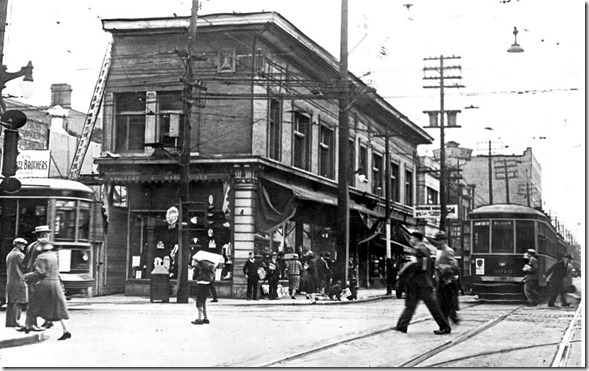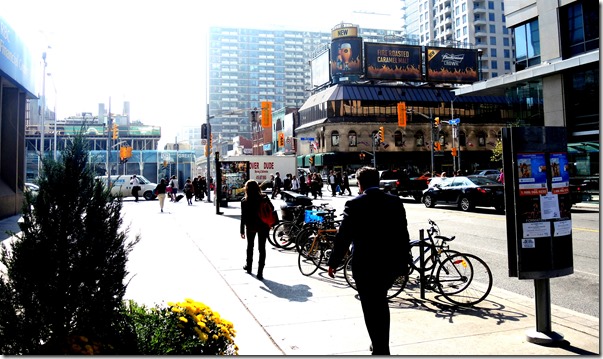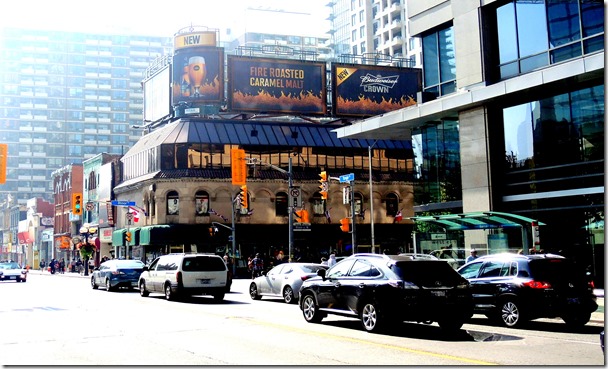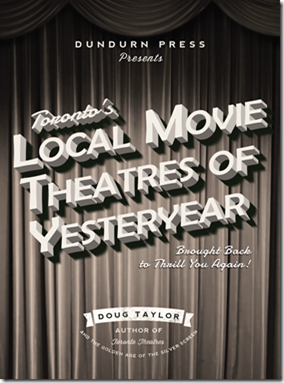Frank Stollery’s store at Yonge and Bloor Streets in the 1970s. Toronto Archives F124, S 1465, fl 0685, it. 109
During the mid-1950s, I was a teenager and worked for one summer at the Imperial Bank at Yonge and Bloor Streets. Each day, on my lunch hour, if I strolled south on Yonge Street, I passed by Stollerys and gazed in the display windows. However, I never ventured inside the store as I knew that the prices were beyond my means. My employment at the bank was $28 per week. At the time, I knew nothing about Stollerys’ long and distinguished history in the city of Toronto’s retail trade.
Frank Stollery was born in Yorkville in 1879, during the days when it was a semi-rural community, surrounded by fields and farms. When he was a boy, residents of Yorkville journeyed to Toronto via the horse-drawn streetcar service on Yonge Street, its terminal being King Street near the St. Lawrence Market. Frank quit school when he was 14, which was not uncommon in that day. He found employment in a shop where he learned the skills required to cut men’s shirts and ties. Being adventurous, he relocated to Montreal and by age 20 was a foreman in a Montreal clothing factory, earning $12 per week. At age 21, he joined the Royal Canadian Regiment, but remained in service only a year. Returning to Toronto in 1901, he borrowed $1000 from his father and opened a haberdashery shop on Yonge Street, south of Bloor. A few years later, he relocated his business to the southwest corner of Bloor and Yonge Streets (1 Bloor Street West). He rented the property, but in 1928, purchased the site and commenced renovations. He also purchased the building to the south of his shop and incorporated it into the store.
However, in 1929, the City expropriated 20 feet on the north side of his shop to widen Bloor Street. This essentially created a situation in which Stollerys and many of the other businesses on the south side of Bloor Street were unable to operate, until the widening had been completed. Undaunted, Stollery demolished a portion of his shop behind the hoarding, and began the construction of a new structure. However, he continued operating in the remainder of the premises until the new building was completed.
The attractive new structure opened about 1930 or 1931. It possessed two-storeys, with large display windows on the ground floor. The windows on the second floor were topped with rounded Roman arches, and the roof possessed red tiles. The decorative stone carvings on the facade reflected Art Deco, with modern Italian trends. The store’s display windows became famous as they were meticulously arranged to feature the most up-to-date styles of expensive suits, jackets, raincoats, ties, shirts, and pyjamas.
Frank retired in 1968, selling the business to his son Arthur, and Ed Whaley, each owning 50 percent of the enterprise. Whaley managed the store, while Frank remained a silent partner. Whaley renovated the store and also leased the building to the immediate south, including it as part of the shop. When the business was at its peak in the 1970s and 1980s, it employed 100 people and it was assets were valued at $30 million.
Frank Stollery died on January 1, 1971 at his home at 32 Teddington Park Avenue, near Yonge Street, seven blocks north of Lawrence Avenue. In the years ahead, due to internal business problems, the store became neglected, the display windows becoming rather shoddy. By the second decade of the 21at century, the value of the land where the shop was located was astronomical. It was sold and quickly demolished in 2015, its demolition accomplished within a single weekend.
Sources: “Toronto Architecture—A City Guide,” by Patricia McHugh— www.thestar.com—www.mountpleasantgroup.com (Mike Filey)— www.theglobeandmail.com—torontoist.com
The camera is pointed at the southwest corner of Bloor and Yonge Streets in 1912. The Frank Stollery men’s shop is on the corner. The photo provides a good view of the west side of Yonge Street, south of Bloor in the second decade of the 20th century. Toronto Archives, F 1231, Item 1691.
Frank Stollery’s shop in 1922, the north facade of the premises facing Bloor Street. The windows have awnings that sheltered potential customers from the summer sun. Sadly, few modern stores offer this feature. Toronto Archives, F 1034, item 816.
Stollery’s in 1923, shadows indicating that it was taken in the morning. The policeman operates a traffic sign as there was no stop lights. Toronto Archives, F1231, Item 2089.
Stollery’s store in 1928, when the shop to the south of it was being incorporated. To accomplish this, half of the old store was demolished. The photo also contains Peter Witt streetcars that began service in Toronto in 1921. Toronto Archives, F1244, item 7393.
The camera is pointed toward the northwest corner of Yonge and Bloor in the 1970s. This is the building that opened in 1930-1931. The red-tiled roof, second-storey rounded windows and the ground-floor display windows are visible. Toronto Archives, F124, File 2, Item 109.
Gazing south on Yonge Street from Bloor Street in the 1980s. A third storey has been added, its facades constructed of glass. Toronto Archives, S 1465, fl0614, Item 002.
Photograph of the southwest corner of Yonge and Bloor in 2013. The camera looks south on Yonge.
Frank Stollery’s store in 2013.
To view the Home Page for this blog: https://tayloronhistory.com/
For more information about the topics explored on this blog:
https://tayloronhistory.com/2016/03/02/tayloronhistory-comcheck-it-out/
The publication entitled, “Toronto’s Theatres and the Golden Age of the Silver Screen,” explores 50 of Toronto’s old theatres and contains over 80 archival photographs of the facades, marquees and interiors of the theatres. It relates anecdotes and stories by the author and others who experienced these grand old movie houses.
To place an order for this book:
Book also available in Chapter/Indigo, the Bell Lightbox and AGO Book Shops, and by phoning University of Toronto Press, Distribution: 416-667-7791 (ISBN 978.1.62619.450.2)
Another book on theatres, published by Dundurn Press, is entitled, “Toronto’s Movie Theatres of Yesteryear—Brought Back to Thrill You Again.” It explores 81 theatres and contains over 125 archival photographs, with interesting anecdotes about these grand old theatres and their fascinating histories.
The book is available at local book stores throughout Toronto or for a link to order this book: https://www.dundurn.com/books/Torontos-Local-Movie-Theatres-Yesteryear
Another publication, “Toronto Then and Now,” published by Pavilion Press (London, England) explores 75 of the city’s heritage sites. It contains archival and modern photos that allow readers to compare scenes and discover how they have changed over the decades. For further information follow the link to Amazon.com here or contact the publisher directly by the link below:
http://www.ipgbook.com/toronto–then-and-now—products-9781910904077.php?page_id=21
![1970s Fonds 124, File 2, It. 109 [1] 1970s Fonds 124, File 2, It. 109 [1]](https://tayloronhistory.com/wp-content/uploads/2016/09/1970s-fonds-124-file-2-it-109-1_thumb.jpg)
![1912- f1231_it1691[1] 1912- f1231_it1691[1]](https://tayloronhistory.com/wp-content/uploads/2016/09/1912-f1231_it16911_thumb.jpg)
![1922, Fonds-1034-Item-816-1024x574[1] 1922, Fonds-1034-Item-816-1024x574[1]](https://tayloronhistory.com/wp-content/uploads/2016/09/1922-fonds-1034-item-816-1024x5741_thumb.jpg)
![1923, f1231_it2089[1] 1923, f1231_it2089[1]](https://tayloronhistory.com/wp-content/uploads/2016/09/1923-f1231_it20891_thumb.jpg)

![1970s Fonds 124, File 2, It. 109 [1] 1970s Fonds 124, File 2, It. 109 [1]](https://tayloronhistory.com/wp-content/uploads/2016/09/1970s-fonds-124-file-2-it-109-1_thumb1.jpg)



![cid_E474E4F9-11FC-42C9-AAAD-1B66D852[2] cid_E474E4F9-11FC-42C9-AAAD-1B66D852[2]](https://tayloronhistory.com/wp-content/uploads/2016/09/cid_e474e4f9-11fc-42c9-aaad-1b66d8522_thumb.jpg)




These are so great!
So sorry but I’m in the hospital fighting a chest infection so please I’ve go to deal with
Thank you and take care Geoff Mann